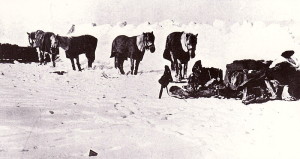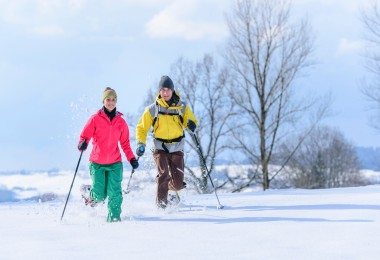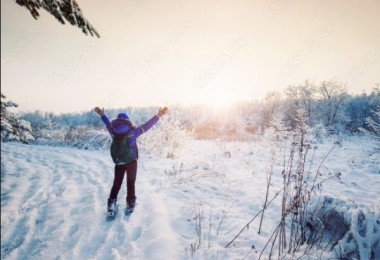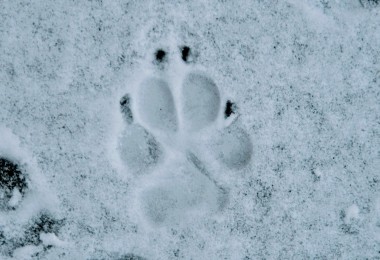We all enjoy putting our snowshoes on, stepping out into that deep powder, plodding away and becoming immersed in that whole snowy wintertime atmosphere. It’s what gets us excited and let’s be honest, snowshoeing an important facet of our very existence. It is also why we readily return to ‘Snowshoe Magazine’, isn’t it? And, snowshoes distribute our weight over a larger area, providing good flotation, which stops us from sinking far down into the white stuff. They are such a simple idea! Great thanks must be awarded to the thinkers who invented them in those snow-bound lands many centuries ago.
As is often the case, both in and out of winter, we might occasionally find ourselves wandering around the internet looking for random snowshoe related items in order to continue to feed this hunger of ours. Just recently on my personal cyber travels, I have been somewhat absorbed in how snowshoes have become adapted for larger creatures so they too might get around in the snow more easily.
In bygone times, horses were essential to many areas of our lives before this current machine age. Working with horses was a particular problem in locations with seasonally deep snow as these large mammals weigh a great deal more than humans. This leads to the problem that horses tend to sink even further down into the snow than we might! Therefore, in farming, forestry and any other areas where horses work in snow, a practical solution came about when snowshoes for horses were ingeniously first designed. There is a fascinating woodcut from a 1555 book by Olaus Magnus showing a merchant travelling with his packhorse in deep snow in the mountains between Norway and Sweden. Both the man and his horse are wearing snowshoes. Remarkable! I decided I needed to find out more about equine snowshoes, which eventually led to my contacting Bjørn Bækkelund from the Norwegian Forestry Museum.
A merchant travelling with his packhorse over the mountains between Sweden and Norway. A woodcut from a book by Olaus Magnus in 1555.
Bjørn explained that horses with snowshoes were used in areas where there was extensive snow in Norway until tractors began to take over in agriculture and forestry during the 1950s. Horses were required to move hay around farms using sledges. Also, when isolated tracks needed to be opened up, horses using snowshoes were used to compress the snow which would then allow for more general movement to take place. These equine snowshoes were constructed in a variety of ways. Some were made of woven birch withy fixed to hooves by chains or leather; others were made from solid pieces of wood; and, more recent versions were made of rubber and even iron.
‘Hestetruger’ or snowshoes for horses. Norsk Folkemuseum, Norway.
Similarly, in Newfoundland, loggers used to place snowshoes on their working horses allowing them to pull greater loads through deep snow. In addition, snowshoes were sometimes used with both horses and mules so that mail and supplies could be carried to remote North American destinations during occasions of plentiful snow. Obviously, in North America, those of the great outdoors were sometimes very creative about using snowshoes for large creatures which, in some instances, has now become part of folklore. Indeed, in one of his legends, the mythical giant logger, Paul Bunyan, made some snowshoes for his ox called Big Blue! The giant made them in order to stop being continually knocked over by Big Blue because the ox couldn’t see where he was going in the thick snow. The story says that, as soon as the ox put them on, he could then make out the lie of the land and thankfully, the unfortunate accidents ceased. (Incidentally, PB and I share the same surname, and my middle name is in fact Paul! There the similarities end because I am no giant, possessing a height of a mere 5 feet, 5 inches!).
A horse wearing snowshoes. Stewart Historical Society Museum, B.C., Canada
On a far more serious note, one of the most fascinating aspects of this entire topic is how snowshoes were used with ponies (or in this case were not used) during Captain Robert Scott’s Antarctic expedition at the beginning of the last century. Scott had decided to take hardy Manchurian ponies to Antarctica on his attempt to be the first person to travel to the South Pole. However the Norwegian, Roald Amundsen, who was in the Antarctic at the same time as Scott, had decided to use huskies in his attempt to be first! So, the scene was set for the now famous Amundsen/Scott race to the South Pole, one with huskies and one with ponies. We know that Amundsen reached the most southerly point on the planet before Scott. The question is, just how much of the outcome of this race was due to Scott selecting ponies over dogs for his main form of Antarctic transportation? Over the years there has been considerable analysis about both of these expeditions and the decisions that were made at that time.
A Manchurian pony called Michael seen standing in the snow during the 1911-12 Captain Scott expedition to the Antarctic.
A great deal of debate has evolved from Captain Scott’s push for the Pole with a claim that if snowshoes had been used on his ponies, and unfortunately they were not, his party might possibly have reached the pole before Amundsen. The Scott expedition had taken enough snowshoes for all the ponies to use during their journey south. These snowshoes or ‘hestetruger’ were the disc type which had been successfully used for a long time in Scandinavia. ‘If equine snowshoes had been used’, says Tom Moates an American equestrian journalist, ‘Scott’s ponies could have doubled their party’s daily mileage’. He therefore suggests they would have travelled considerably quicker before the ponies became exhausted and were then shot for food. These are the main conclusions from a study by the US ‘Long Riders’ Guild Academic Foundation’. Scott himself had become convinced that by using hestetruger the ponies would be able to travel further over the snowy terrain of the Antarctic. He therefore had the shoes so why were they not employed?
Manchurian ponies resting after hauling sledges in the Antarctic during Scott’s expedition.
The need to avoid ponies struggling in the snow became apparent during preparations for the expedition’s push for the pole. In areas of soft snow Scott wrote that it was horrible to see them ‘half engulfed in the snow, panting and heaving’ (from Theodore Mason’s book ‘The South Pole Ponies’). When Scott tried hestetruger on a pony called Weary Willy he trotted around as though walking on hard ground, leading the captain to conclude that they were ‘worth their weight in gold’. Both Mason and Moates are convinced that the reason why the use of snowshoes was discouraged was all due to Captain Lawrence Oates, the man in charge of the ponies during this British expedition. In short, Oates was against the use of snowshoes on ponies calling them an ‘unmitigated nuisance’ which led to their not being used. Only one set of shoes was taken when the expedition set off for the Pole. On realising that the rest of the shoes had been left behind, Scott sent two members of the group back to collect them. Unfortunately melted sea-ice put a halt to their mission. Therefore, the journey took a great deal of time as far as the Beardmore Glacier, roughly half way to their destination. The ponies found the going very challenging, often sinking deeply in areas with considerable snow. The men then helped in the hauling which resulted in both ponies and men becoming exhausted. Ponies had to be shot earlier in their trek to the Polar Plateau (which was always planned, but not until later on during their journey). This led to more rations being consumed due to the greater effort being exerted by the explorers. Consequently, the man-hauling section of the trek across the Polar Plateau to the South Pole fell behind schedule. These series of events had a knock-on effect and once they had reached the pole their return was made more difficult with diminished rations. The final tragedy came eleven miles from safety where the remaining members sadly perished. The unfortunate group was eventually discovered by a search party using mules brought from the Himalayas, wearing equine snowshoes.

Square snowshoes made from pieces of wood. Norsk Skogmuseum/Norwegian Forestry Museum
When you next plod through snow, with your snowshoes upon your feet, spare a thought or two for much larger bodies than yours, that have or perhaps have not, employed their use.
Enjoy your next season’s snowshoeing!











Deplorable. Shot and ate the creatures who were actually doing the work. Great example of why humans are a terrible species. Ponies should have run off and left the men to die.
I agree, horse lover. It was incredibly sad that the ponies were ridden to exhaustion and shot for food. I wish that the Scott expedition would have ended differently for all involved, including the horses. 🙁 -Susan, Snowshoe Mag Editor
As an avid horse rider, I LOVED this article. Would you consider adding a button we can click to share articles (such as this) on our social media sites, specifically FB – thank you so much!
Sherry,
I’m glad you enjoyed this article!
If you look at the top of the article right under the article title, to the right of the author’s name, it should be there. We currently have Facebook, twitter, and google+ setup.
Thanks,
Paul Wowk
dugh! Thank you … should drink my coffee first!